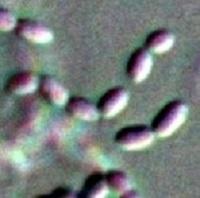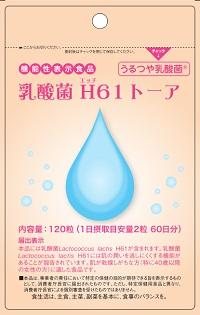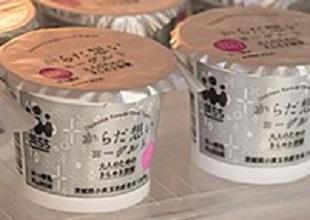


Lactococcus lactis H61, discovered by the Institute of Livestock and Grassland Science, NARO (NILGS) (currently the Institute of Livestock and Grassland Science, Tsukuba City, Ibaraki Prefecture), has effects such as "inhibiting the loss of moisture in the skin of middle-aged women" as a result of a study with humans. The results of this research led to the creation of food products with the functional claim label "food product suitable for persons concerned about skin moisture", and regional specialty products such as yogurt in Ibaraki and Iwate Prefectures. In addition, an experiment with mice showed inhibition of the decline in hearing function associated with aging, and there are great expectations for future research aimed at preventing hearing loss in elderly persons.
A large number of products developed through industry-government-academia collaboration
|
Lactococcus lactis H61 (Fig.1) is a lactic acid bacterium selected by NARO from among various lactic acid bacteria used when making cheese. The official name is "Lactococcus lactis subsp. cremoris". As a result of various experiments carried out by NARO, it has been found that it has effects related to anti-aging with mice. Following these results,more scientific evidence was published, and in 2020, the Consumer Affairs Agency accepted the notification of the supplement ingredient "Lactococcus lactis H61 TOA" (Fig.2) as a food product with a functional claim. This food product is manufactured independently by Toa Pharmaceutical Industry Co., Ltd. under license from NARO. Supplements that utilize this strain are already being sold by several companies. In Ibaraki Prefecture, yogurt has been produced as a result of cooperation among industry, government, and academia. With the cooperation of Ibaraki Prefecture, Tsukuba City, and the University of Tsukuba, the Omitama City third sector company Omitama Furusato Food Corporation sells yogurt containing Lactococcus lactis H61 called "Karada Omoi" (Fig.3). Japan Agricultural Cooperative (JA) Hitachi also sells a drinkable yogurt "Lilia", which has a cheese flavor. |
 Fig.1 Lactococcus lactis H61 bacterial strain (Provided by Hiromi Kimoto)  Fig.2 "Lactococcus lactis H61 TOA", for which the notification for a food product with a functional claim |

Fig.3 Yogurt using Lactococcus lactis H61
(From the website of Omitama Furusato Food Corporation)
In Shizukuishi Town, Iwate Prefecture, Matsubara Farm, which is known for its handmade ice cream, has started selling yogurt using Lactococcus lactis H61 under the name of "Bokusha No Yogurt". The range of utilization is expanding to Tohoku area.
Since Lactococcus lactis H61 can be used in a wide range of processed foods such as pet food, NARO, which holds patents on bacterial cells, expects active and effective use by private companies.
Inhibition of skin moisture loss
The first research leading to the functionality of these products was a study involving humans conducted by Dr. Hiromi Kimoto, head of the Institute of Livestock and Grassland Science, NARO (NILGS).
The subjects comprised women in their 30s to 60s, who were divided into two groups: one receiving potato starch containing heat-treated Lactococcus lactis H61 (60 mg/day, approximately 40 billion lactic acid bacteria), and the other receiving potato starch alone (placebo); the subjects were requested to intake it for eight weeks from autumn to winter, a period when skin dries out, and it was investigated whether there would be any difference in skin condition. This study is a highly reliable double-blind comparative study in which it is impossible to know which subjects ingest real lactic acid bacteria.
The results revealed that while there was no difference between the two groups among subjects in their 20s to 40s, among subjects in in their 50s to 60s, the H61 intake group experienced a significant inhibition of the decrease in the seasonal moisture content of the forearm skin after 8 weeks. The results of a self-assessment questionnaire showed that those in their 30s in the H61 intake group experienced improved skin elasticity, while number of those in their 50s and 60s gave high evaluations, noting that apparent hair follicles in the cheek and dryness of the throat was improved.
In addition, in an experiment in which women in their 30s to 60s drank drinking yogurt made using Lactococcus lactis H61, the results of self-evaluation revealed high scores for improvement of skin elasticity, texture, and darkness.
Could it prevent age-related hearing loss?
Hideaki Oike, a principal scietist at the Institute of Food Research, NARO (NFRI), gave mice a diet mixed with dry powder (killed bacteria) of Lactococcus lactis H61, and examined the effects on age-related hearing loss. When hearing was measured six months later, it was found that the death of auditory nerve cells was inhibited in the mice fed with Lactococcus lactis H61 and the decline in hearing was inhibited in comparison with the mice that fed food that did not contain strain H61. Dr. Oike commented, "When people become old and experience hearing loss, they lose communication with others, and there is a risk that dementia will progress. We would like to further study whether Lactococcus lactis H61 leads to the prevention of dementia through prevention of hearing loss."
Project name
Research Program on Development of Innovative Technology
Project period
FY 2010 to 2012
Title
Elucidation of health functionality related to biological defense and development of effective utilization technology, etc.
Leading research institutes
Institute of Food Research, NARO (NFRI), Institute of Livestock and Grassland Science, NARO (NILGS), etc.
